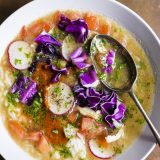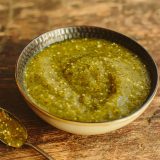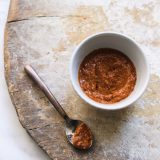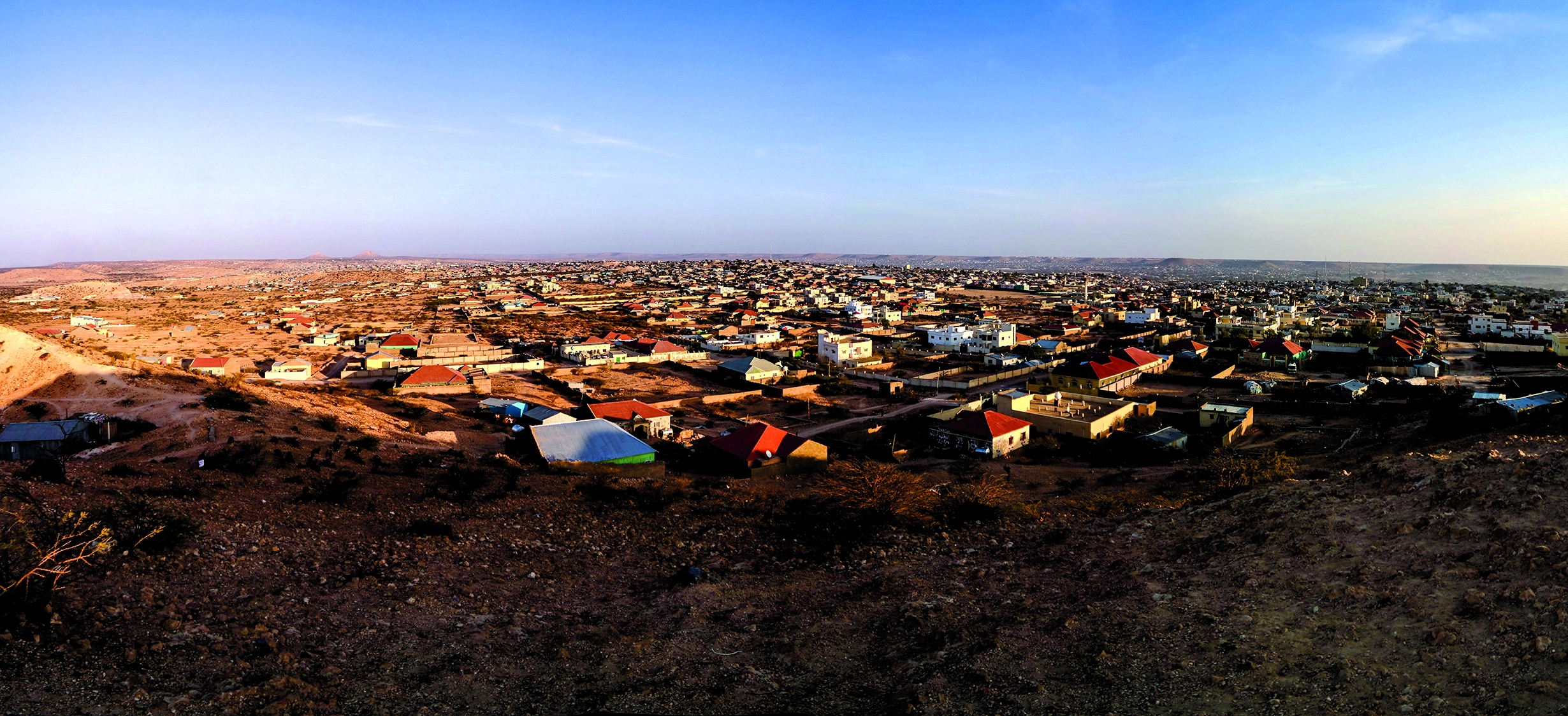
Winter in Somalia is mild and muggy. In the dry, mountainous north, a chilly night might reach 50°F. In the south, closer to the equator, it seldom dips below 70°F. But whatever one's definition of cold, the best succor for the weather in Somalia is the same as elsewhere: hot soup.
Maraq cad (Somali for clear soup) starts as most soups do. Take meat—typically lamb or goat—and simmer it in water with vegetables. Season it with spices and aromatics, maybe coriander, cilantro and garlic. Once the flavors have melded, ladle it into a bowl over cooked rice or potatoes, to add some starch.
It’s the finishing touches that top the soup that transform maraq cad. Peppery arugula, sweet-and-spicy daikon radishes and crisp white cabbage, all added at the last moment, each retaining its bright, bold flavor and texture.
They’re followed by hot sauces—one dusky red with spices, the other verdant with green chilies—that dye the soup deep pink and electrify the otherwise delicate broth.
“This is my peasant food,” says Somalia native, Massachusetts caterer and Milk Street cooking instructor Nimco Mahamud-Hassan. The connotation is entirely positive.
Nimco remembers watching her mother make maraq cad in their kitchen in Hargeisa, a city in the northwestern corner of Somalia where she lived until she was 12. It wasn’t until she was 17 and living in London that she made the soup on her own, from memory. Over the years she’s made modifications—swapping in whole chicken, straining the broth, adding red cabbage and scallions—to tailor it, to make it her own.
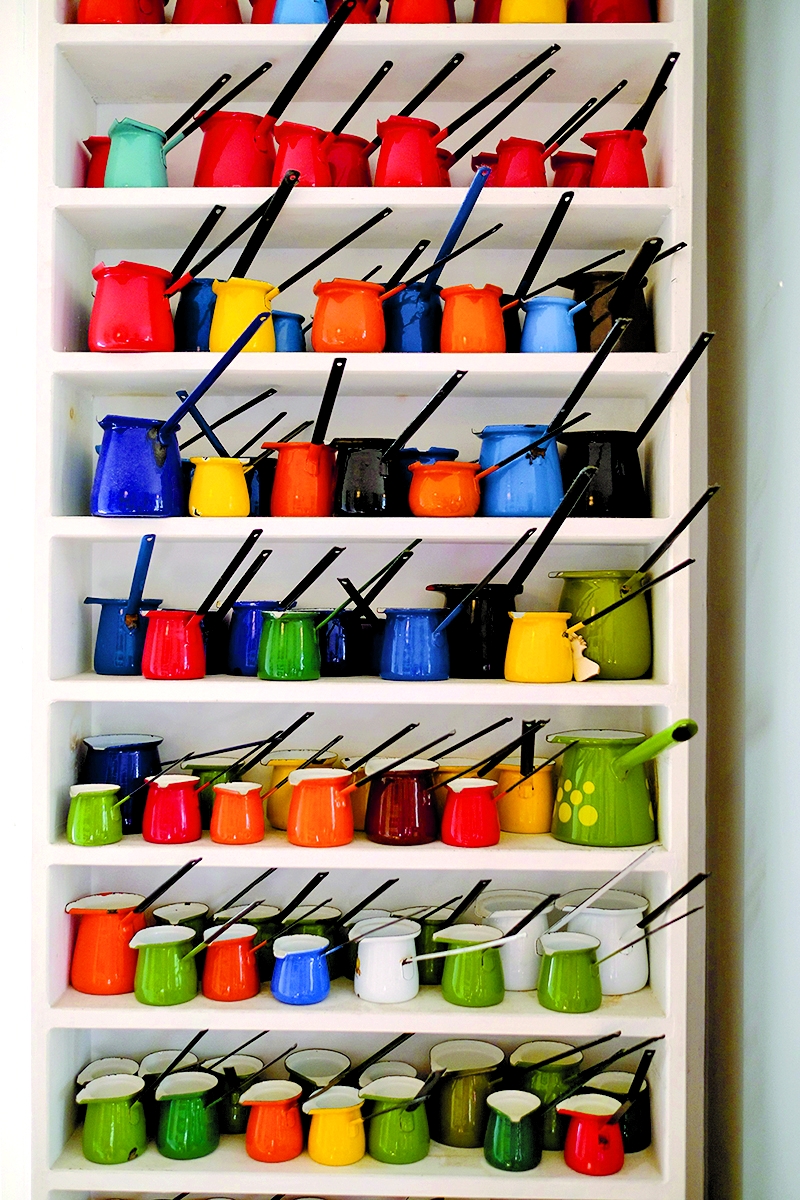
I visit Nimco at her home on a sleepy side street in Somerville. Her mint-green clapboard house and the stylish kitchen within are a long way from where she grew up in Hargeisa, in its well-known red light district. But between both homes, one thing remains the same: “There’s always something cooking.”
That’s what she remembers best about her childhood kitchen after being away for 32 years: Someone was always cooking and someone was always cleaning.
The charcoal-fueled oven was made of concrete and iron, with vents and spaces for lighting fires and setting pots and pans. One of her older sisters, Ayaan, was especially proficient at manipulating this setup.
“When you can bake a cake on a charcoal fire, you are really skilled,” Nimco says. Her sister would place coals all around a pot, even the lid, to evenly bake desserts (a rarity in Somali cuisine).
In her early years, Ayaan taught Nimco to cook. She remembers learning the method for lahoh, a spongy, yeasted, pancake-like flatbread made with sorghum flour and cooked on a griddle; a stack is usually served with ghee, honey or sugar, plus tea. Ayaan would make a batch for the family’s breakfast, letting Nimco make the last pancake for practice. One day, Ayaan let her take over. “I remember feeling very proud the morning I made them for everyone else.”
Nimco still makes lahoh occasionally, but the sorghum flour here lacks the nutty, slightly sour taste it has in Somalia. Maraq cad—more easily adapted to the American kitchen—is a regular part of her repertoire, warming her kitchen during Massachusetts’ frigid winters.
She starts simple—a Dutch oven, a whole chicken, chopped onion, quartered plum tomatoes and a handful of salt. The chicken she slits at the thighs so she can fold them underneath the breast in the pot. She adds water in two stages—first 2 cups, then another 6 after 10 minutes’ time—a technique that keeps the propped-up white meat from cooking the entire time.
The simmering soup, left untouched for the next half-hour, becomes a soundtrack as Nimco prepares rice, garnishes and the hot sauces. In five minutes, the broth’s aroma fills the kitchen air.
First she makes rice. Though basmati is more readily available, Nimco uses broken rice—grains that are fragmented during processing and therefore deemed damaged and sold for a lower price. Broken rice is a staple in Vietnam, but it’s also common in parts of Africa, especially West Africa, where some consumers prefer it to whole grains. Nimco likes the texture and appearance of the cracked rice, which she buys at a local Asian market.
Next she prepares the hot sauces. Meals in Somalia are meat-driven and shared among large families (the average Somali woman has six children; Nimco is one of 13), so food often starts plain, but spicy condiments are always at the ready.
For the first sauce, she combines lime juice, minced red onion and brick-red berbere, a spice blend made from dried chilies, garlic, ginger, fenugreek, cardamom, cumin and other spices, depending on the cook. Berbere migrated into Somali cuisine from Ethiopia, its neighbor to the west, but it’s widely used throughout Somalia, either as a paste mixed with oil or citrus or sprinkled on straight, as one might with pan-fried slices of camel or lamb liver.
The next sauce is shidni. It’s one of many Somali hot sauces (or basbaas), which besides chilies and citrus can include yogurt, dates or tamarind. Nimco’s recipe is simple: just serranos, tomato, garlic, lime juice and salt. She pulverizes everything to a smooth, vibrant green sauce with an immersion blender. She serves the shidni with a small spoon, a tacit signal to use with caution.

The result is a transformative chicken soup, one as novel as it is comforting, and even more delicious. Where long-simmered soups often result in a one-note flavor and uniformity of texture, maraq cad offers distinct, bright layers, each bite a mix of textures.
With the additions prepared, Nimco returns to the soup. She lifts the lid and steam billows toward her smiling face. She adds cilantro, a fistful of ground coriander and garlic and covers the pot for a few more minutes. Then, the maraq cad is ready.
It comes together like pho: first the starch, then broth and shreds of meat, finally the garnishes.
The bowl Nimco assembles for me is beautiful and multi-textured, adorned with strips of red cabbage, white wafers of radish, threads of arugula and squat cylinders of scallions. The berbere gives the broth complexity and acidity, the shidni brings bite. Each spoonful of saturated rice is addictive. The radish and cabbage wilt only slightly, providing crunch. The dark meat is tender. It’s the best chicken soup I’ve ever tasted
At Milk Street, we make some small adjustments—swapping in bone-in chicken breasts, building complexity into the broth, swapping out broken rice and blending our own berbere—to streamline Nimco’s recipe. But at its heart and in its flavor, it remains true to hers.
